Addiction Counselling: Analysis of Alcohol, Marijuana & Tobacco Use
VerifiedAdded on 2023/06/07
|13
|2919
|332
Essay
AI Summary
This essay provides an overview of addiction counseling with a specific focus on substance abuse in Australia, examining the history, popularity, and effects of alcohol, marijuana, and tobacco. It reviews videos and documentaries to illustrate the cultural and environmental factors contributing to addiction, including the impact of colonization on alcohol consumption and the legalization of marijuana for medicinal purposes. The essay details the short-term and long-term effects of each substance on physical and mental health, social life, and economic stability, as well as the withdrawal symptoms and the role of the environment in promoting substance use. It also touches on potential interventions and the importance of medical and psychological support in overcoming addiction. The study concludes by highlighting the complex interplay of factors that contribute to substance abuse and the need for comprehensive counseling and treatment strategies.
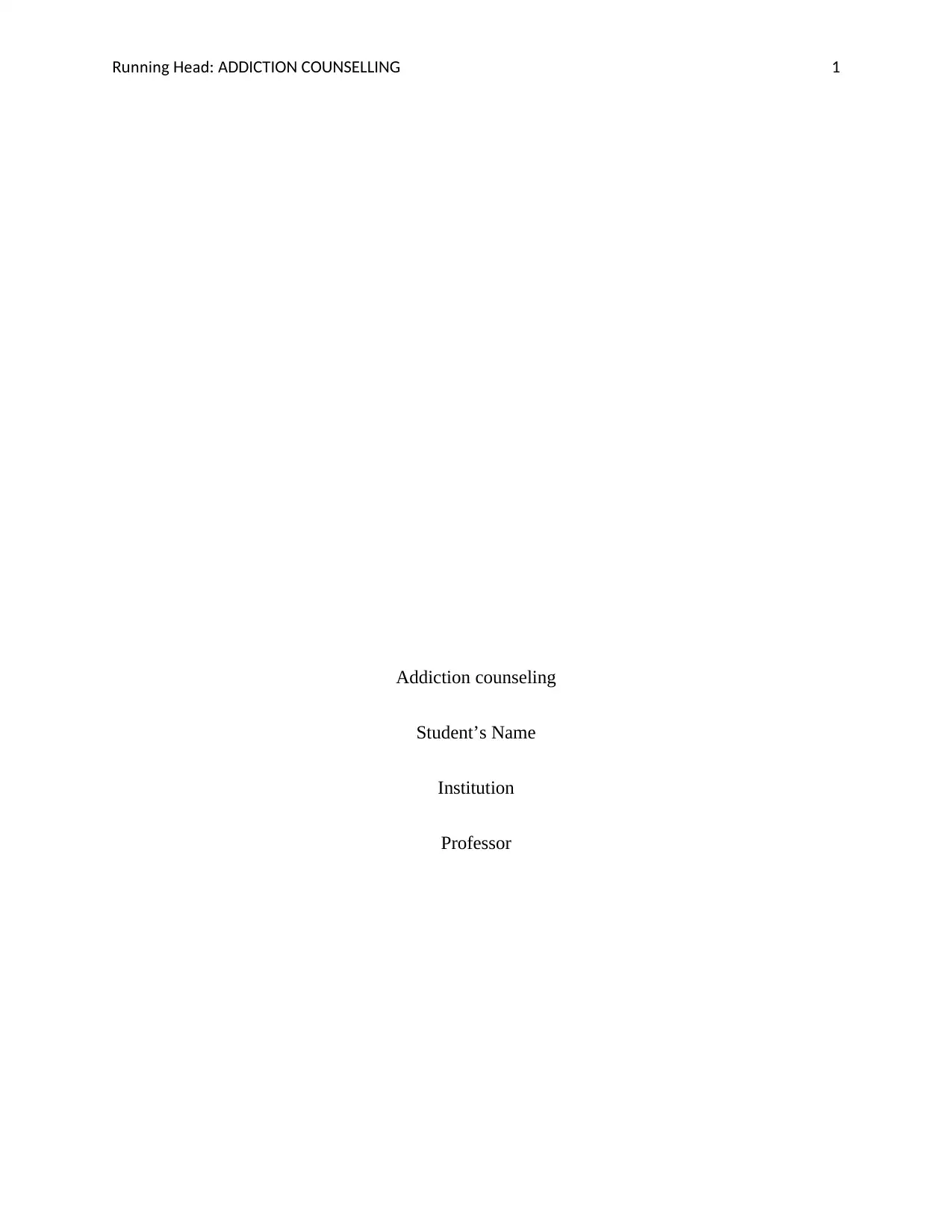
nnin ead A TRu g H : DDIC ION COUNSELLING 1
Addiction counseling
Student’s Name
Institution
Professor
Addiction counseling
Student’s Name
Institution
Professor
Paraphrase This Document
Need a fresh take? Get an instant paraphrase of this document with our AI Paraphraser
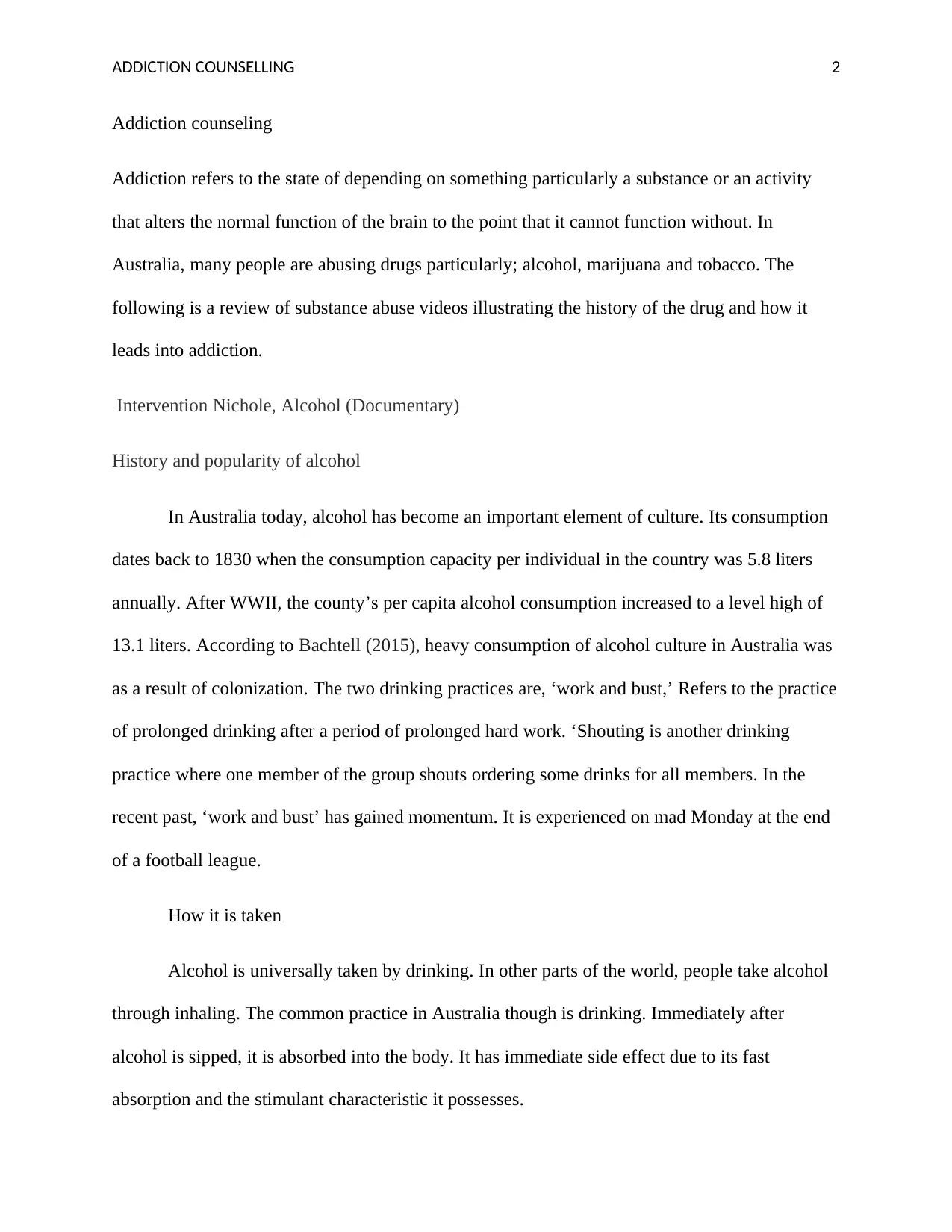
A TDDIC ION COUNSELLING 2
Addiction counseling
Addiction refers to the state of depending on something particularly a substance or an activity
that alters the normal function of the brain to the point that it cannot function without. In
Australia, many people are abusing drugs particularly; alcohol, marijuana and tobacco. The
following is a review of substance abuse videos illustrating the history of the drug and how it
leads into addiction.
Intervention Nichole, Alcohol (Documentary)
History and popularity of alcohol
In Australia today, alcohol has become an important element of culture. Its consumption
dates back to 1830 when the consumption capacity per individual in the country was 5.8 liters
annually. After WWII, the county’s per capita alcohol consumption increased to a level high of
13.1 liters. According to Bachtell (2015), heavy consumption of alcohol culture in Australia was
as a result of colonization. The two drinking practices are, ‘work and bust,’ Refers to the practice
of prolonged drinking after a period of prolonged hard work. ‘Shouting is another drinking
practice where one member of the group shouts ordering some drinks for all members. In the
recent past, ‘work and bust’ has gained momentum. It is experienced on mad Monday at the end
of a football league.
How it is taken
Alcohol is universally taken by drinking. In other parts of the world, people take alcohol
through inhaling. The common practice in Australia though is drinking. Immediately after
alcohol is sipped, it is absorbed into the body. It has immediate side effect due to its fast
absorption and the stimulant characteristic it possesses.
Addiction counseling
Addiction refers to the state of depending on something particularly a substance or an activity
that alters the normal function of the brain to the point that it cannot function without. In
Australia, many people are abusing drugs particularly; alcohol, marijuana and tobacco. The
following is a review of substance abuse videos illustrating the history of the drug and how it
leads into addiction.
Intervention Nichole, Alcohol (Documentary)
History and popularity of alcohol
In Australia today, alcohol has become an important element of culture. Its consumption
dates back to 1830 when the consumption capacity per individual in the country was 5.8 liters
annually. After WWII, the county’s per capita alcohol consumption increased to a level high of
13.1 liters. According to Bachtell (2015), heavy consumption of alcohol culture in Australia was
as a result of colonization. The two drinking practices are, ‘work and bust,’ Refers to the practice
of prolonged drinking after a period of prolonged hard work. ‘Shouting is another drinking
practice where one member of the group shouts ordering some drinks for all members. In the
recent past, ‘work and bust’ has gained momentum. It is experienced on mad Monday at the end
of a football league.
How it is taken
Alcohol is universally taken by drinking. In other parts of the world, people take alcohol
through inhaling. The common practice in Australia though is drinking. Immediately after
alcohol is sipped, it is absorbed into the body. It has immediate side effect due to its fast
absorption and the stimulant characteristic it possesses.
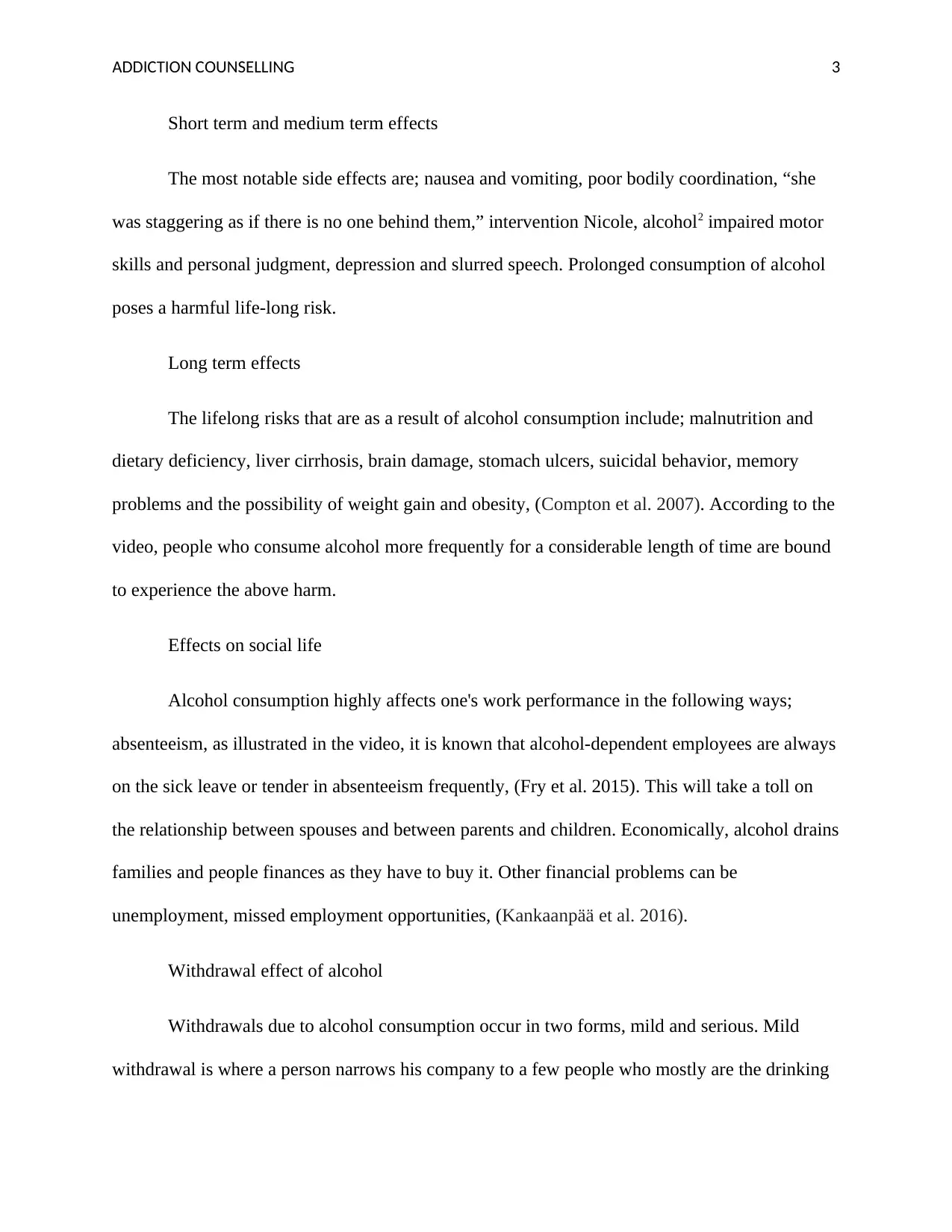
A TDDIC ION COUNSELLING 3
Short term and medium term effects
The most notable side effects are; nausea and vomiting, poor bodily coordination, “she
was staggering as if there is no one behind them,” intervention Nicole, alcohol2 impaired motor
skills and personal judgment, depression and slurred speech. Prolonged consumption of alcohol
poses a harmful life-long risk.
Long term effects
The lifelong risks that are as a result of alcohol consumption include; malnutrition and
dietary deficiency, liver cirrhosis, brain damage, stomach ulcers, suicidal behavior, memory
problems and the possibility of weight gain and obesity, (Compton et al. 2007). According to the
video, people who consume alcohol more frequently for a considerable length of time are bound
to experience the above harm.
Effects on social life
Alcohol consumption highly affects one's work performance in the following ways;
absenteeism, as illustrated in the video, it is known that alcohol-dependent employees are always
on the sick leave or tender in absenteeism frequently, (Fry et al. 2015). This will take a toll on
the relationship between spouses and between parents and children. Economically, alcohol drains
families and people finances as they have to buy it. Other financial problems can be
unemployment, missed employment opportunities, (Kankaanpää et al. 2016).
Withdrawal effect of alcohol
Withdrawals due to alcohol consumption occur in two forms, mild and serious. Mild
withdrawal is where a person narrows his company to a few people who mostly are the drinking
Short term and medium term effects
The most notable side effects are; nausea and vomiting, poor bodily coordination, “she
was staggering as if there is no one behind them,” intervention Nicole, alcohol2 impaired motor
skills and personal judgment, depression and slurred speech. Prolonged consumption of alcohol
poses a harmful life-long risk.
Long term effects
The lifelong risks that are as a result of alcohol consumption include; malnutrition and
dietary deficiency, liver cirrhosis, brain damage, stomach ulcers, suicidal behavior, memory
problems and the possibility of weight gain and obesity, (Compton et al. 2007). According to the
video, people who consume alcohol more frequently for a considerable length of time are bound
to experience the above harm.
Effects on social life
Alcohol consumption highly affects one's work performance in the following ways;
absenteeism, as illustrated in the video, it is known that alcohol-dependent employees are always
on the sick leave or tender in absenteeism frequently, (Fry et al. 2015). This will take a toll on
the relationship between spouses and between parents and children. Economically, alcohol drains
families and people finances as they have to buy it. Other financial problems can be
unemployment, missed employment opportunities, (Kankaanpää et al. 2016).
Withdrawal effect of alcohol
Withdrawals due to alcohol consumption occur in two forms, mild and serious. Mild
withdrawal is where a person narrows his company to a few people who mostly are the drinking
⊘ This is a preview!⊘
Do you want full access?
Subscribe today to unlock all pages.

Trusted by 1+ million students worldwide
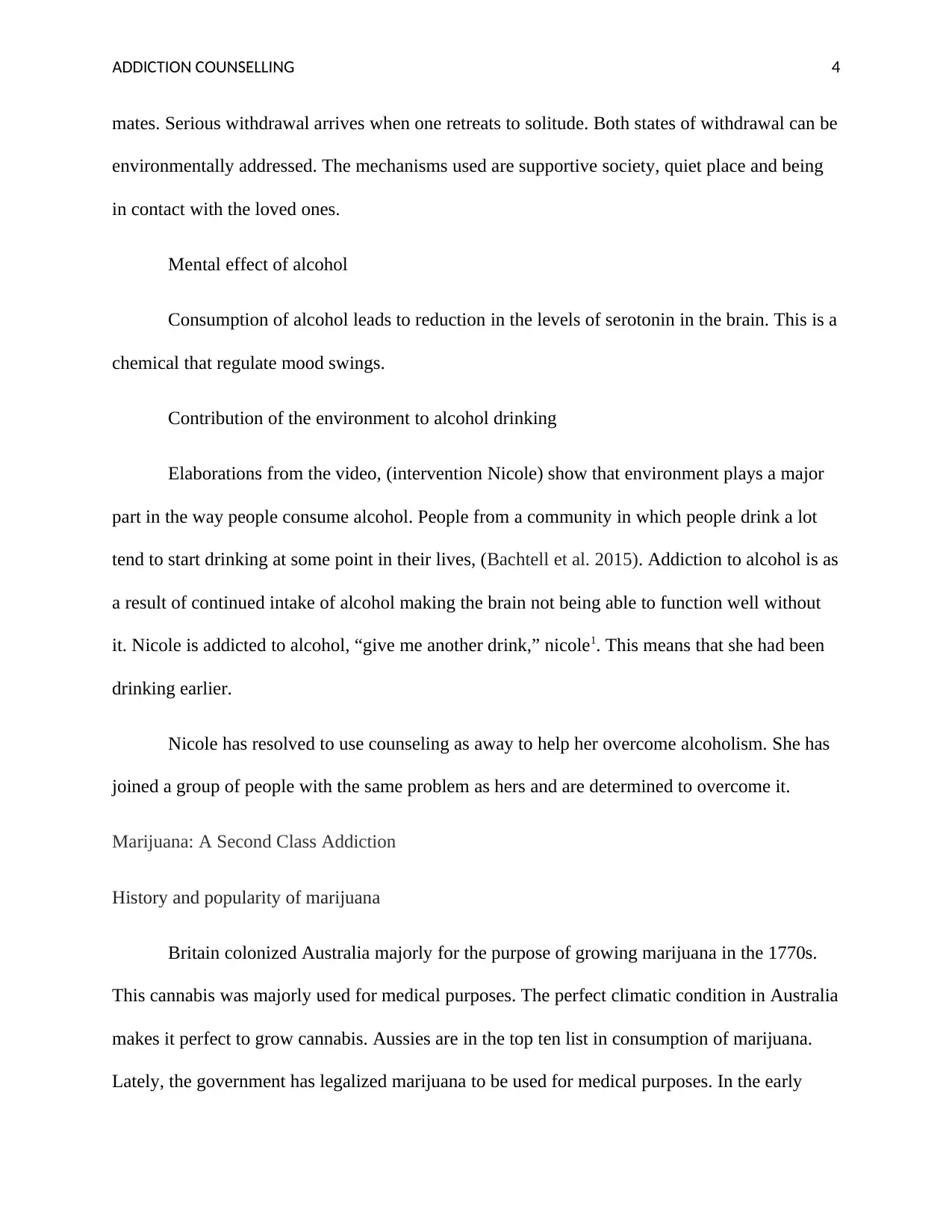
A TDDIC ION COUNSELLING 4
mates. Serious withdrawal arrives when one retreats to solitude. Both states of withdrawal can be
environmentally addressed. The mechanisms used are supportive society, quiet place and being
in contact with the loved ones.
Mental effect of alcohol
Consumption of alcohol leads to reduction in the levels of serotonin in the brain. This is a
chemical that regulate mood swings.
Contribution of the environment to alcohol drinking
Elaborations from the video, (intervention Nicole) show that environment plays a major
part in the way people consume alcohol. People from a community in which people drink a lot
tend to start drinking at some point in their lives, (Bachtell et al. 2015). Addiction to alcohol is as
a result of continued intake of alcohol making the brain not being able to function well without
it. Nicole is addicted to alcohol, “give me another drink,” nicole1. This means that she had been
drinking earlier.
Nicole has resolved to use counseling as away to help her overcome alcoholism. She has
joined a group of people with the same problem as hers and are determined to overcome it.
Marijuana: A Second Class Addiction
History and popularity of marijuana
Britain colonized Australia majorly for the purpose of growing marijuana in the 1770s.
This cannabis was majorly used for medical purposes. The perfect climatic condition in Australia
makes it perfect to grow cannabis. Aussies are in the top ten list in consumption of marijuana.
Lately, the government has legalized marijuana to be used for medical purposes. In the early
mates. Serious withdrawal arrives when one retreats to solitude. Both states of withdrawal can be
environmentally addressed. The mechanisms used are supportive society, quiet place and being
in contact with the loved ones.
Mental effect of alcohol
Consumption of alcohol leads to reduction in the levels of serotonin in the brain. This is a
chemical that regulate mood swings.
Contribution of the environment to alcohol drinking
Elaborations from the video, (intervention Nicole) show that environment plays a major
part in the way people consume alcohol. People from a community in which people drink a lot
tend to start drinking at some point in their lives, (Bachtell et al. 2015). Addiction to alcohol is as
a result of continued intake of alcohol making the brain not being able to function well without
it. Nicole is addicted to alcohol, “give me another drink,” nicole1. This means that she had been
drinking earlier.
Nicole has resolved to use counseling as away to help her overcome alcoholism. She has
joined a group of people with the same problem as hers and are determined to overcome it.
Marijuana: A Second Class Addiction
History and popularity of marijuana
Britain colonized Australia majorly for the purpose of growing marijuana in the 1770s.
This cannabis was majorly used for medical purposes. The perfect climatic condition in Australia
makes it perfect to grow cannabis. Aussies are in the top ten list in consumption of marijuana.
Lately, the government has legalized marijuana to be used for medical purposes. In the early
Paraphrase This Document
Need a fresh take? Get an instant paraphrase of this document with our AI Paraphraser
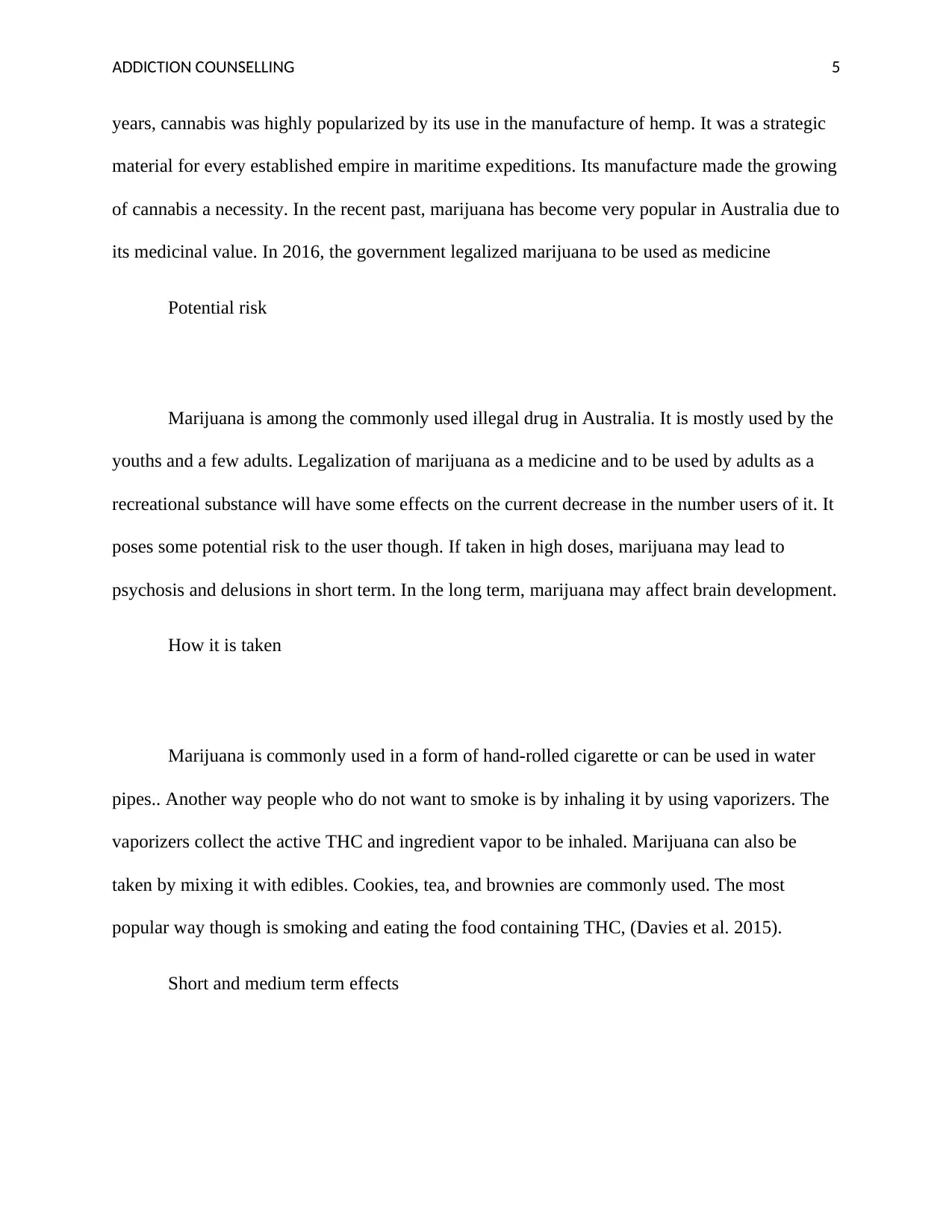
A TDDIC ION COUNSELLING 5
years, cannabis was highly popularized by its use in the manufacture of hemp. It was a strategic
material for every established empire in maritime expeditions. Its manufacture made the growing
of cannabis a necessity. In the recent past, marijuana has become very popular in Australia due to
its medicinal value. In 2016, the government legalized marijuana to be used as medicine
Potential risk
Marijuana is among the commonly used illegal drug in Australia. It is mostly used by the
youths and a few adults. Legalization of marijuana as a medicine and to be used by adults as a
recreational substance will have some effects on the current decrease in the number users of it. It
poses some potential risk to the user though. If taken in high doses, marijuana may lead to
psychosis and delusions in short term. In the long term, marijuana may affect brain development.
How it is taken
Marijuana is commonly used in a form of hand-rolled cigarette or can be used in water
pipes.. Another way people who do not want to smoke is by inhaling it by using vaporizers. The
vaporizers collect the active THC and ingredient vapor to be inhaled. Marijuana can also be
taken by mixing it with edibles. Cookies, tea, and brownies are commonly used. The most
popular way though is smoking and eating the food containing THC, (Davies et al. 2015).
Short and medium term effects
years, cannabis was highly popularized by its use in the manufacture of hemp. It was a strategic
material for every established empire in maritime expeditions. Its manufacture made the growing
of cannabis a necessity. In the recent past, marijuana has become very popular in Australia due to
its medicinal value. In 2016, the government legalized marijuana to be used as medicine
Potential risk
Marijuana is among the commonly used illegal drug in Australia. It is mostly used by the
youths and a few adults. Legalization of marijuana as a medicine and to be used by adults as a
recreational substance will have some effects on the current decrease in the number users of it. It
poses some potential risk to the user though. If taken in high doses, marijuana may lead to
psychosis and delusions in short term. In the long term, marijuana may affect brain development.
How it is taken
Marijuana is commonly used in a form of hand-rolled cigarette or can be used in water
pipes.. Another way people who do not want to smoke is by inhaling it by using vaporizers. The
vaporizers collect the active THC and ingredient vapor to be inhaled. Marijuana can also be
taken by mixing it with edibles. Cookies, tea, and brownies are commonly used. The most
popular way though is smoking and eating the food containing THC, (Davies et al. 2015).
Short and medium term effects
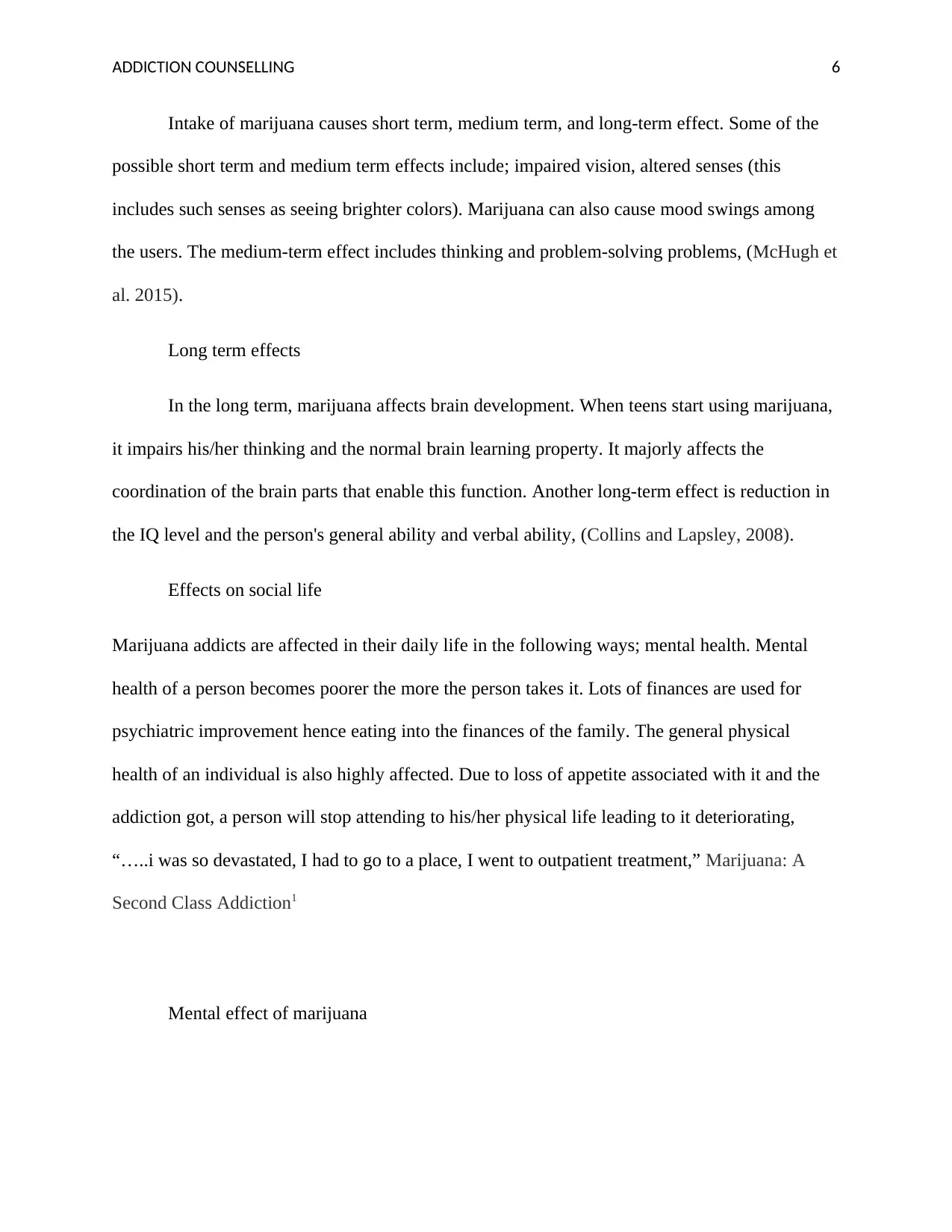
A TDDIC ION COUNSELLING 6
Intake of marijuana causes short term, medium term, and long-term effect. Some of the
possible short term and medium term effects include; impaired vision, altered senses (this
includes such senses as seeing brighter colors). Marijuana can also cause mood swings among
the users. The medium-term effect includes thinking and problem-solving problems, (McHugh et
al. 2015).
Long term effects
In the long term, marijuana affects brain development. When teens start using marijuana,
it impairs his/her thinking and the normal brain learning property. It majorly affects the
coordination of the brain parts that enable this function. Another long-term effect is reduction in
the IQ level and the person's general ability and verbal ability, (Collins and Lapsley, 2008).
Effects on social life
Marijuana addicts are affected in their daily life in the following ways; mental health. Mental
health of a person becomes poorer the more the person takes it. Lots of finances are used for
psychiatric improvement hence eating into the finances of the family. The general physical
health of an individual is also highly affected. Due to loss of appetite associated with it and the
addiction got, a person will stop attending to his/her physical life leading to it deteriorating,
“…..i was so devastated, I had to go to a place, I went to outpatient treatment,” Marijuana: A
Second Class Addiction1
Mental effect of marijuana
Intake of marijuana causes short term, medium term, and long-term effect. Some of the
possible short term and medium term effects include; impaired vision, altered senses (this
includes such senses as seeing brighter colors). Marijuana can also cause mood swings among
the users. The medium-term effect includes thinking and problem-solving problems, (McHugh et
al. 2015).
Long term effects
In the long term, marijuana affects brain development. When teens start using marijuana,
it impairs his/her thinking and the normal brain learning property. It majorly affects the
coordination of the brain parts that enable this function. Another long-term effect is reduction in
the IQ level and the person's general ability and verbal ability, (Collins and Lapsley, 2008).
Effects on social life
Marijuana addicts are affected in their daily life in the following ways; mental health. Mental
health of a person becomes poorer the more the person takes it. Lots of finances are used for
psychiatric improvement hence eating into the finances of the family. The general physical
health of an individual is also highly affected. Due to loss of appetite associated with it and the
addiction got, a person will stop attending to his/her physical life leading to it deteriorating,
“…..i was so devastated, I had to go to a place, I went to outpatient treatment,” Marijuana: A
Second Class Addiction1
Mental effect of marijuana
⊘ This is a preview!⊘
Do you want full access?
Subscribe today to unlock all pages.

Trusted by 1+ million students worldwide
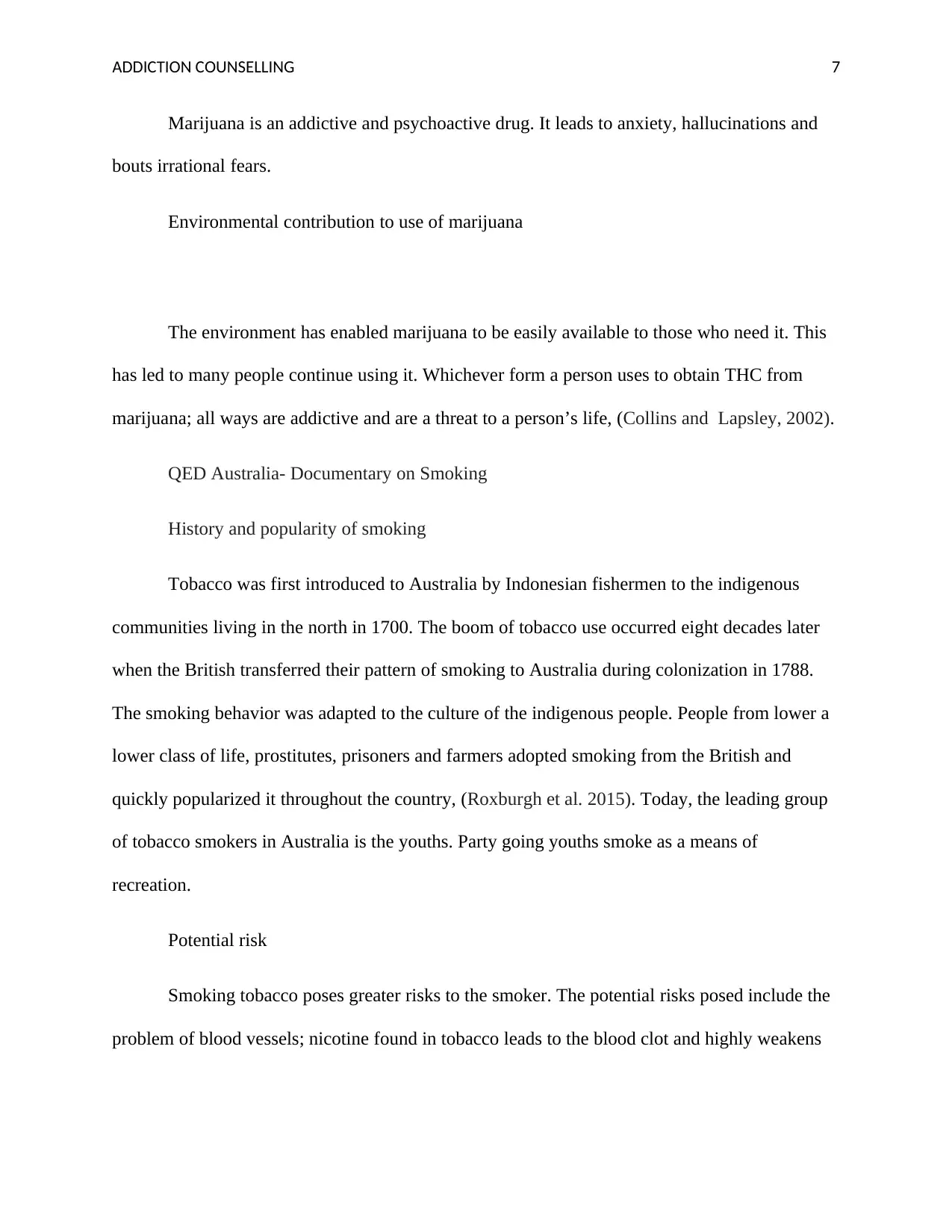
A TDDIC ION COUNSELLING 7
Marijuana is an addictive and psychoactive drug. It leads to anxiety, hallucinations and
bouts irrational fears.
Environmental contribution to use of marijuana
The environment has enabled marijuana to be easily available to those who need it. This
has led to many people continue using it. Whichever form a person uses to obtain THC from
marijuana; all ways are addictive and are a threat to a person’s life, (Collins and Lapsley, 2002).
QED Australia- Documentary on Smoking
History and popularity of smoking
Tobacco was first introduced to Australia by Indonesian fishermen to the indigenous
communities living in the north in 1700. The boom of tobacco use occurred eight decades later
when the British transferred their pattern of smoking to Australia during colonization in 1788.
The smoking behavior was adapted to the culture of the indigenous people. People from lower a
lower class of life, prostitutes, prisoners and farmers adopted smoking from the British and
quickly popularized it throughout the country, (Roxburgh et al. 2015). Today, the leading group
of tobacco smokers in Australia is the youths. Party going youths smoke as a means of
recreation.
Potential risk
Smoking tobacco poses greater risks to the smoker. The potential risks posed include the
problem of blood vessels; nicotine found in tobacco leads to the blood clot and highly weakens
Marijuana is an addictive and psychoactive drug. It leads to anxiety, hallucinations and
bouts irrational fears.
Environmental contribution to use of marijuana
The environment has enabled marijuana to be easily available to those who need it. This
has led to many people continue using it. Whichever form a person uses to obtain THC from
marijuana; all ways are addictive and are a threat to a person’s life, (Collins and Lapsley, 2002).
QED Australia- Documentary on Smoking
History and popularity of smoking
Tobacco was first introduced to Australia by Indonesian fishermen to the indigenous
communities living in the north in 1700. The boom of tobacco use occurred eight decades later
when the British transferred their pattern of smoking to Australia during colonization in 1788.
The smoking behavior was adapted to the culture of the indigenous people. People from lower a
lower class of life, prostitutes, prisoners and farmers adopted smoking from the British and
quickly popularized it throughout the country, (Roxburgh et al. 2015). Today, the leading group
of tobacco smokers in Australia is the youths. Party going youths smoke as a means of
recreation.
Potential risk
Smoking tobacco poses greater risks to the smoker. The potential risks posed include the
problem of blood vessels; nicotine found in tobacco leads to the blood clot and highly weakens
Paraphrase This Document
Need a fresh take? Get an instant paraphrase of this document with our AI Paraphraser
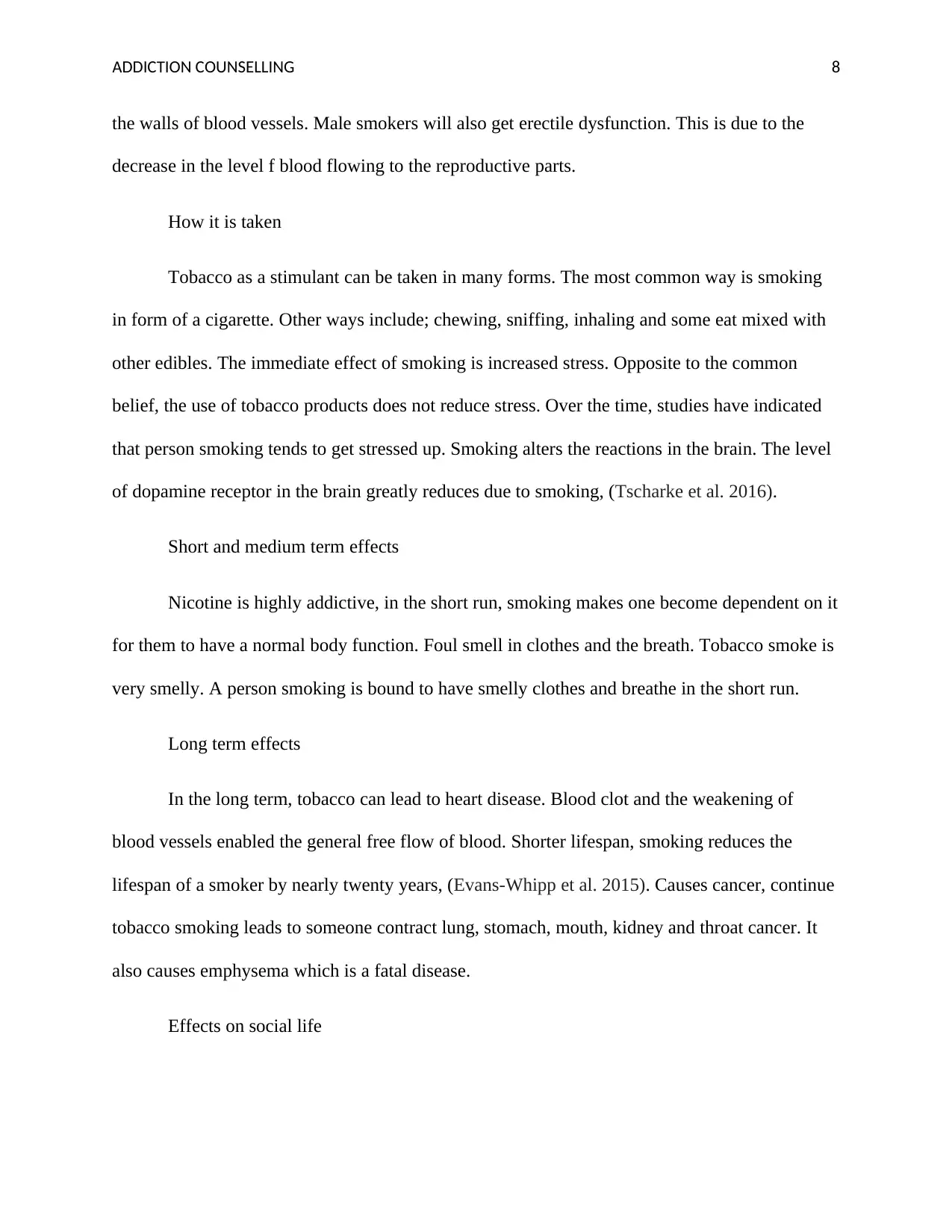
A TDDIC ION COUNSELLING 8
the walls of blood vessels. Male smokers will also get erectile dysfunction. This is due to the
decrease in the level f blood flowing to the reproductive parts.
How it is taken
Tobacco as a stimulant can be taken in many forms. The most common way is smoking
in form of a cigarette. Other ways include; chewing, sniffing, inhaling and some eat mixed with
other edibles. The immediate effect of smoking is increased stress. Opposite to the common
belief, the use of tobacco products does not reduce stress. Over the time, studies have indicated
that person smoking tends to get stressed up. Smoking alters the reactions in the brain. The level
of dopamine receptor in the brain greatly reduces due to smoking, (Tscharke et al. 2016).
Short and medium term effects
Nicotine is highly addictive, in the short run, smoking makes one become dependent on it
for them to have a normal body function. Foul smell in clothes and the breath. Tobacco smoke is
very smelly. A person smoking is bound to have smelly clothes and breathe in the short run.
Long term effects
In the long term, tobacco can lead to heart disease. Blood clot and the weakening of
blood vessels enabled the general free flow of blood. Shorter lifespan, smoking reduces the
lifespan of a smoker by nearly twenty years, (Evans-Whipp et al. 2015). Causes cancer, continue
tobacco smoking leads to someone contract lung, stomach, mouth, kidney and throat cancer. It
also causes emphysema which is a fatal disease.
Effects on social life
the walls of blood vessels. Male smokers will also get erectile dysfunction. This is due to the
decrease in the level f blood flowing to the reproductive parts.
How it is taken
Tobacco as a stimulant can be taken in many forms. The most common way is smoking
in form of a cigarette. Other ways include; chewing, sniffing, inhaling and some eat mixed with
other edibles. The immediate effect of smoking is increased stress. Opposite to the common
belief, the use of tobacco products does not reduce stress. Over the time, studies have indicated
that person smoking tends to get stressed up. Smoking alters the reactions in the brain. The level
of dopamine receptor in the brain greatly reduces due to smoking, (Tscharke et al. 2016).
Short and medium term effects
Nicotine is highly addictive, in the short run, smoking makes one become dependent on it
for them to have a normal body function. Foul smell in clothes and the breath. Tobacco smoke is
very smelly. A person smoking is bound to have smelly clothes and breathe in the short run.
Long term effects
In the long term, tobacco can lead to heart disease. Blood clot and the weakening of
blood vessels enabled the general free flow of blood. Shorter lifespan, smoking reduces the
lifespan of a smoker by nearly twenty years, (Evans-Whipp et al. 2015). Causes cancer, continue
tobacco smoking leads to someone contract lung, stomach, mouth, kidney and throat cancer. It
also causes emphysema which is a fatal disease.
Effects on social life
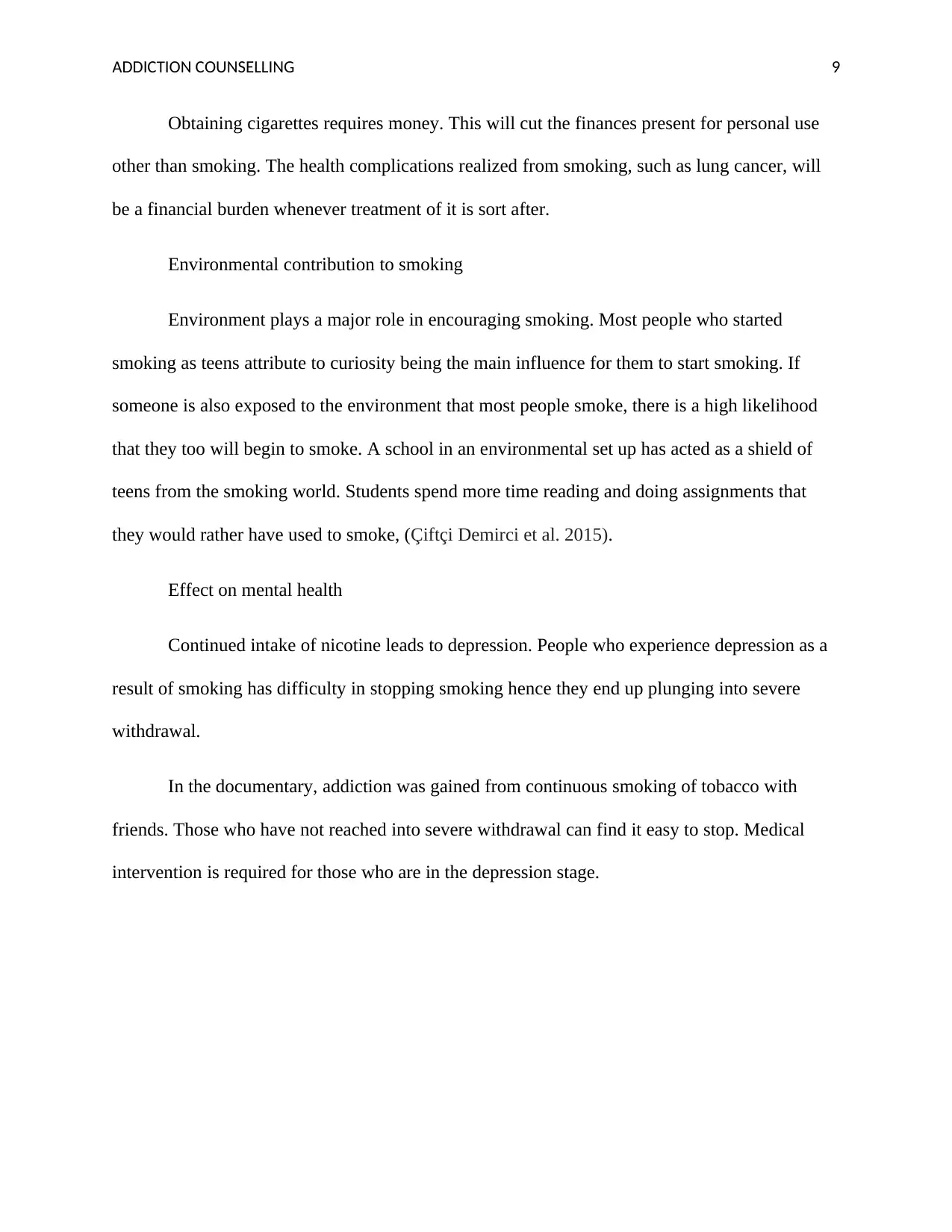
A TDDIC ION COUNSELLING 9
Obtaining cigarettes requires money. This will cut the finances present for personal use
other than smoking. The health complications realized from smoking, such as lung cancer, will
be a financial burden whenever treatment of it is sort after.
Environmental contribution to smoking
Environment plays a major role in encouraging smoking. Most people who started
smoking as teens attribute to curiosity being the main influence for them to start smoking. If
someone is also exposed to the environment that most people smoke, there is a high likelihood
that they too will begin to smoke. A school in an environmental set up has acted as a shield of
teens from the smoking world. Students spend more time reading and doing assignments that
they would rather have used to smoke, (Çiftçi Demirci et al. 2015).
Effect on mental health
Continued intake of nicotine leads to depression. People who experience depression as a
result of smoking has difficulty in stopping smoking hence they end up plunging into severe
withdrawal.
In the documentary, addiction was gained from continuous smoking of tobacco with
friends. Those who have not reached into severe withdrawal can find it easy to stop. Medical
intervention is required for those who are in the depression stage.
Obtaining cigarettes requires money. This will cut the finances present for personal use
other than smoking. The health complications realized from smoking, such as lung cancer, will
be a financial burden whenever treatment of it is sort after.
Environmental contribution to smoking
Environment plays a major role in encouraging smoking. Most people who started
smoking as teens attribute to curiosity being the main influence for them to start smoking. If
someone is also exposed to the environment that most people smoke, there is a high likelihood
that they too will begin to smoke. A school in an environmental set up has acted as a shield of
teens from the smoking world. Students spend more time reading and doing assignments that
they would rather have used to smoke, (Çiftçi Demirci et al. 2015).
Effect on mental health
Continued intake of nicotine leads to depression. People who experience depression as a
result of smoking has difficulty in stopping smoking hence they end up plunging into severe
withdrawal.
In the documentary, addiction was gained from continuous smoking of tobacco with
friends. Those who have not reached into severe withdrawal can find it easy to stop. Medical
intervention is required for those who are in the depression stage.
⊘ This is a preview!⊘
Do you want full access?
Subscribe today to unlock all pages.

Trusted by 1+ million students worldwide
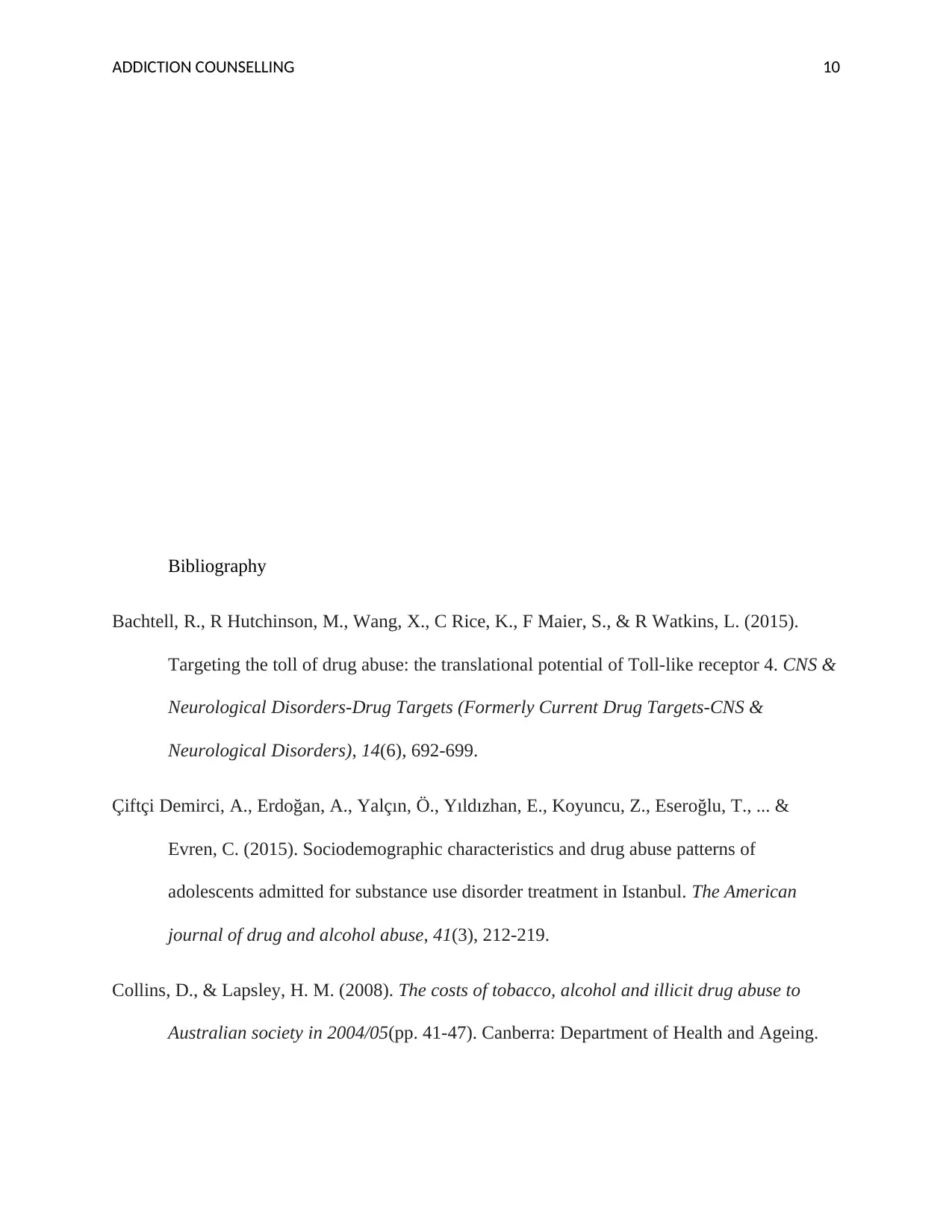
A TDDIC ION COUNSELLING 10
Bibliography
Bachtell, R., R Hutchinson, M., Wang, X., C Rice, K., F Maier, S., & R Watkins, L. (2015).
Targeting the toll of drug abuse: the translational potential of Toll-like receptor 4. CNS &
Neurological Disorders-Drug Targets (Formerly Current Drug Targets-CNS &
Neurological Disorders), 14(6), 692-699.
Çiftçi Demirci, A., Erdoğan, A., Yalçın, Ö., Yıldızhan, E., Koyuncu, Z., Eseroğlu, T., ... &
Evren, C. (2015). Sociodemographic characteristics and drug abuse patterns of
adolescents admitted for substance use disorder treatment in Istanbul. The American
journal of drug and alcohol abuse, 41(3), 212-219.
Collins, D., & Lapsley, H. M. (2008). The costs of tobacco, alcohol and illicit drug abuse to
Australian society in 2004/05(pp. 41-47). Canberra: Department of Health and Ageing.
Bibliography
Bachtell, R., R Hutchinson, M., Wang, X., C Rice, K., F Maier, S., & R Watkins, L. (2015).
Targeting the toll of drug abuse: the translational potential of Toll-like receptor 4. CNS &
Neurological Disorders-Drug Targets (Formerly Current Drug Targets-CNS &
Neurological Disorders), 14(6), 692-699.
Çiftçi Demirci, A., Erdoğan, A., Yalçın, Ö., Yıldızhan, E., Koyuncu, Z., Eseroğlu, T., ... &
Evren, C. (2015). Sociodemographic characteristics and drug abuse patterns of
adolescents admitted for substance use disorder treatment in Istanbul. The American
journal of drug and alcohol abuse, 41(3), 212-219.
Collins, D., & Lapsley, H. M. (2008). The costs of tobacco, alcohol and illicit drug abuse to
Australian society in 2004/05(pp. 41-47). Canberra: Department of Health and Ageing.
Paraphrase This Document
Need a fresh take? Get an instant paraphrase of this document with our AI Paraphraser
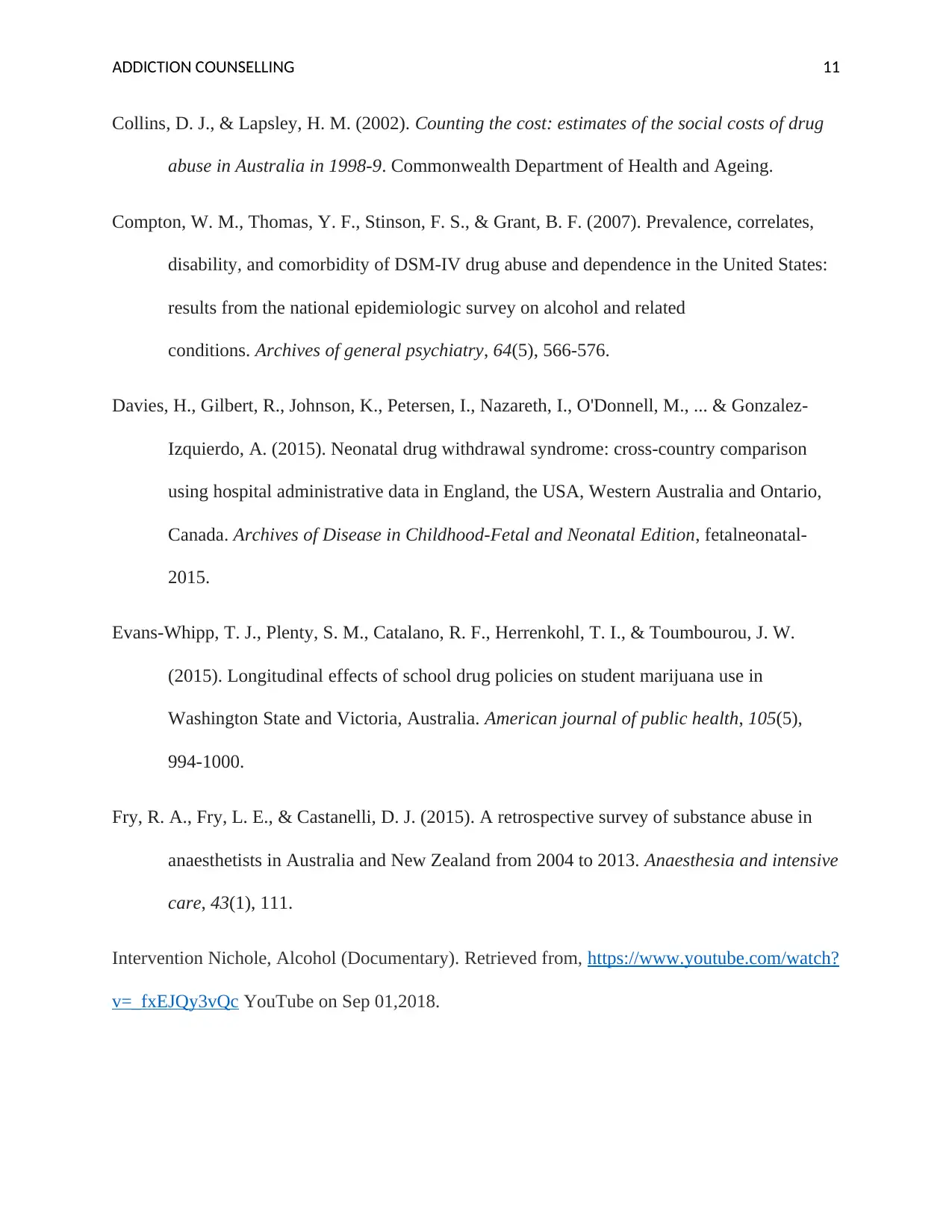
A TDDIC ION COUNSELLING 11
Collins, D. J., & Lapsley, H. M. (2002). Counting the cost: estimates of the social costs of drug
abuse in Australia in 1998-9. Commonwealth Department of Health and Ageing.
Compton, W. M., Thomas, Y. F., Stinson, F. S., & Grant, B. F. (2007). Prevalence, correlates,
disability, and comorbidity of DSM-IV drug abuse and dependence in the United States:
results from the national epidemiologic survey on alcohol and related
conditions. Archives of general psychiatry, 64(5), 566-576.
Davies, H., Gilbert, R., Johnson, K., Petersen, I., Nazareth, I., O'Donnell, M., ... & Gonzalez-
Izquierdo, A. (2015). Neonatal drug withdrawal syndrome: cross-country comparison
using hospital administrative data in England, the USA, Western Australia and Ontario,
Canada. Archives of Disease in Childhood-Fetal and Neonatal Edition, fetalneonatal-
2015.
Evans-Whipp, T. J., Plenty, S. M., Catalano, R. F., Herrenkohl, T. I., & Toumbourou, J. W.
(2015). Longitudinal effects of school drug policies on student marijuana use in
Washington State and Victoria, Australia. American journal of public health, 105(5),
994-1000.
Fry, R. A., Fry, L. E., & Castanelli, D. J. (2015). A retrospective survey of substance abuse in
anaesthetists in Australia and New Zealand from 2004 to 2013. Anaesthesia and intensive
care, 43(1), 111.
Intervention Nichole, Alcohol (Documentary). Retrieved from, https://www.youtube.com/watch?
v=_fxEJQy3vQc YouTube on Sep 01,2018.
Collins, D. J., & Lapsley, H. M. (2002). Counting the cost: estimates of the social costs of drug
abuse in Australia in 1998-9. Commonwealth Department of Health and Ageing.
Compton, W. M., Thomas, Y. F., Stinson, F. S., & Grant, B. F. (2007). Prevalence, correlates,
disability, and comorbidity of DSM-IV drug abuse and dependence in the United States:
results from the national epidemiologic survey on alcohol and related
conditions. Archives of general psychiatry, 64(5), 566-576.
Davies, H., Gilbert, R., Johnson, K., Petersen, I., Nazareth, I., O'Donnell, M., ... & Gonzalez-
Izquierdo, A. (2015). Neonatal drug withdrawal syndrome: cross-country comparison
using hospital administrative data in England, the USA, Western Australia and Ontario,
Canada. Archives of Disease in Childhood-Fetal and Neonatal Edition, fetalneonatal-
2015.
Evans-Whipp, T. J., Plenty, S. M., Catalano, R. F., Herrenkohl, T. I., & Toumbourou, J. W.
(2015). Longitudinal effects of school drug policies on student marijuana use in
Washington State and Victoria, Australia. American journal of public health, 105(5),
994-1000.
Fry, R. A., Fry, L. E., & Castanelli, D. J. (2015). A retrospective survey of substance abuse in
anaesthetists in Australia and New Zealand from 2004 to 2013. Anaesthesia and intensive
care, 43(1), 111.
Intervention Nichole, Alcohol (Documentary). Retrieved from, https://www.youtube.com/watch?
v=_fxEJQy3vQc YouTube on Sep 01,2018.
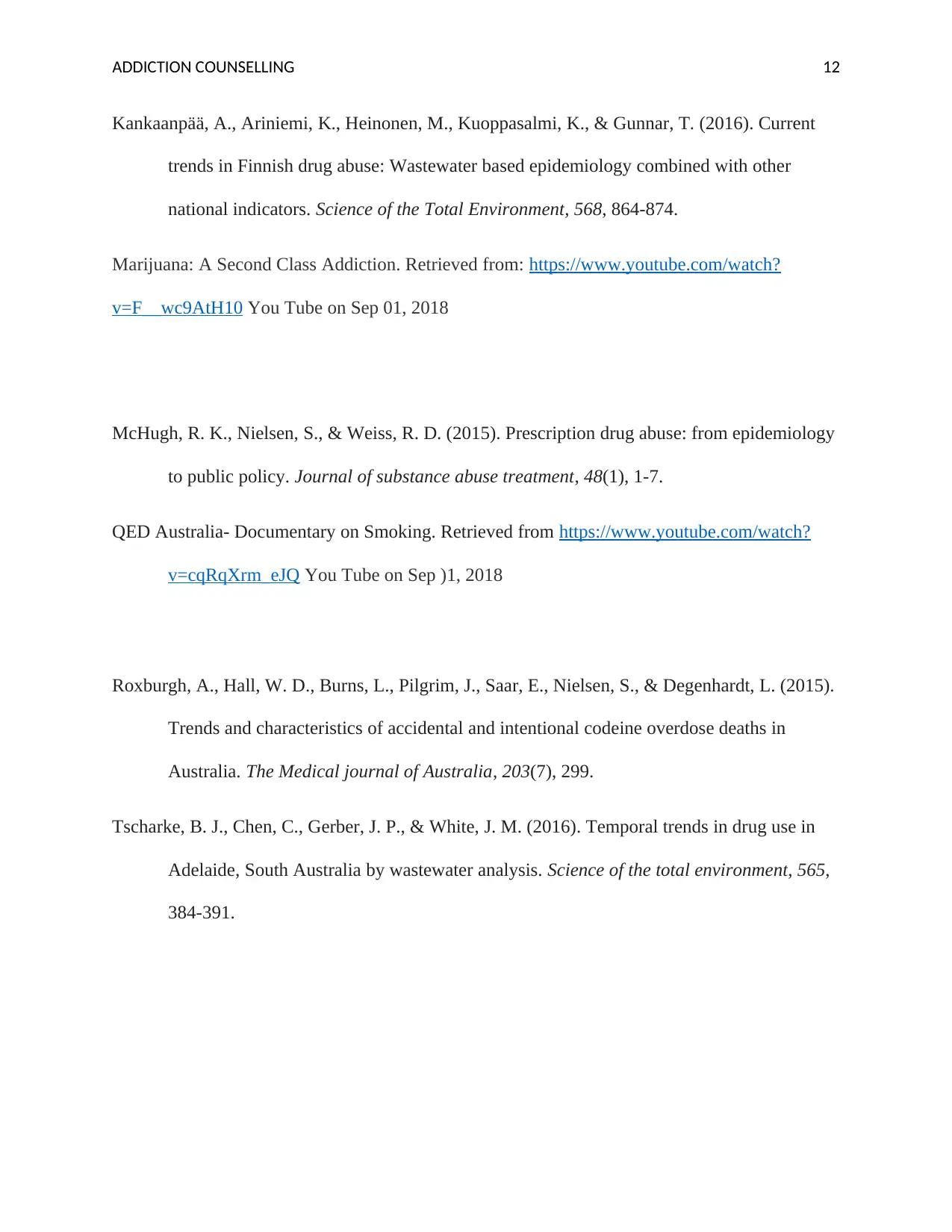
A TDDIC ION COUNSELLING 12
Kankaanpää, A., Ariniemi, K., Heinonen, M., Kuoppasalmi, K., & Gunnar, T. (2016). Current
trends in Finnish drug abuse: Wastewater based epidemiology combined with other
national indicators. Science of the Total Environment, 568, 864-874.
Marijuana: A Second Class Addiction. Retrieved from: https://www.youtube.com/watch?
v=F__wc9AtH10 You Tube on Sep 01, 2018
McHugh, R. K., Nielsen, S., & Weiss, R. D. (2015). Prescription drug abuse: from epidemiology
to public policy. Journal of substance abuse treatment, 48(1), 1-7.
QED Australia- Documentary on Smoking. Retrieved from https://www.youtube.com/watch?
v=cqRqXrm_eJQ You Tube on Sep )1, 2018
Roxburgh, A., Hall, W. D., Burns, L., Pilgrim, J., Saar, E., Nielsen, S., & Degenhardt, L. (2015).
Trends and characteristics of accidental and intentional codeine overdose deaths in
Australia. The Medical journal of Australia, 203(7), 299.
Tscharke, B. J., Chen, C., Gerber, J. P., & White, J. M. (2016). Temporal trends in drug use in
Adelaide, South Australia by wastewater analysis. Science of the total environment, 565,
384-391.
Kankaanpää, A., Ariniemi, K., Heinonen, M., Kuoppasalmi, K., & Gunnar, T. (2016). Current
trends in Finnish drug abuse: Wastewater based epidemiology combined with other
national indicators. Science of the Total Environment, 568, 864-874.
Marijuana: A Second Class Addiction. Retrieved from: https://www.youtube.com/watch?
v=F__wc9AtH10 You Tube on Sep 01, 2018
McHugh, R. K., Nielsen, S., & Weiss, R. D. (2015). Prescription drug abuse: from epidemiology
to public policy. Journal of substance abuse treatment, 48(1), 1-7.
QED Australia- Documentary on Smoking. Retrieved from https://www.youtube.com/watch?
v=cqRqXrm_eJQ You Tube on Sep )1, 2018
Roxburgh, A., Hall, W. D., Burns, L., Pilgrim, J., Saar, E., Nielsen, S., & Degenhardt, L. (2015).
Trends and characteristics of accidental and intentional codeine overdose deaths in
Australia. The Medical journal of Australia, 203(7), 299.
Tscharke, B. J., Chen, C., Gerber, J. P., & White, J. M. (2016). Temporal trends in drug use in
Adelaide, South Australia by wastewater analysis. Science of the total environment, 565,
384-391.
⊘ This is a preview!⊘
Do you want full access?
Subscribe today to unlock all pages.

Trusted by 1+ million students worldwide
1 out of 13
Your All-in-One AI-Powered Toolkit for Academic Success.
+13062052269
info@desklib.com
Available 24*7 on WhatsApp / Email
![[object Object]](/_next/static/media/star-bottom.7253800d.svg)
Unlock your academic potential
Copyright © 2020–2025 A2Z Services. All Rights Reserved. Developed and managed by ZUCOL.


